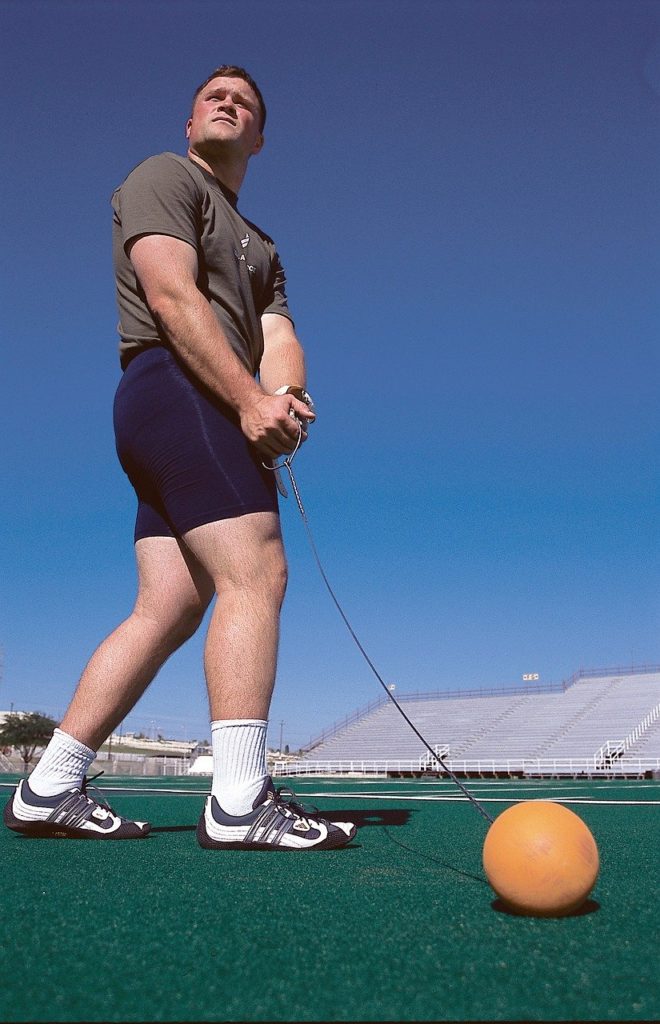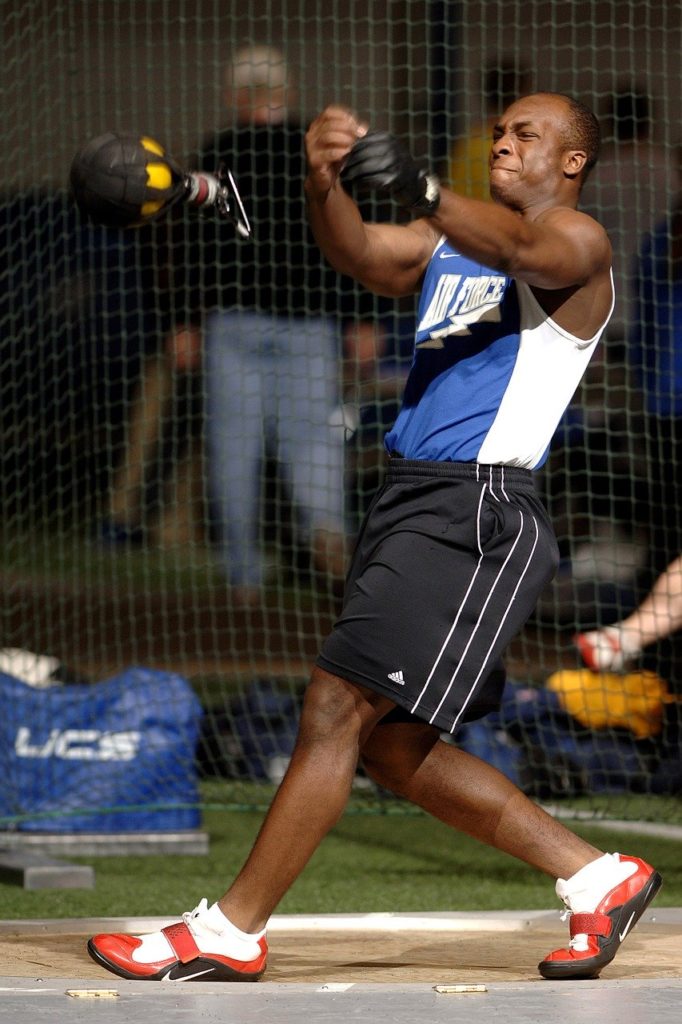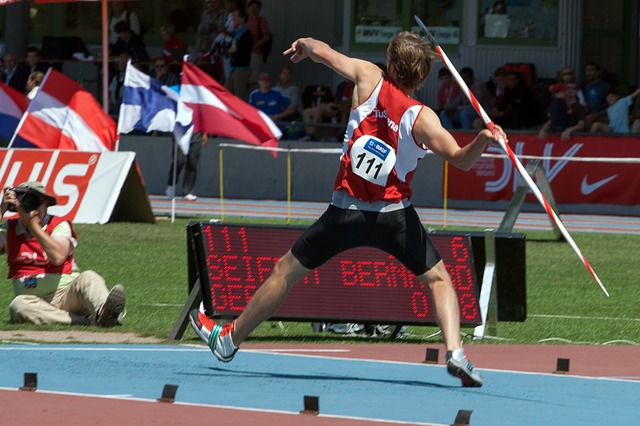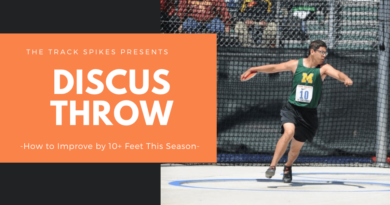Which of the Throwing Events Should I Compete In?
Beginners often don’t know which of the throwing events to start first. In this post, we’ll breakdown how to know which event is best for you.
I got lucky. I started track & field in middle school. My coach encouraged me to try shot put. However, some athletes don’t know where to start. Thankfully, you’re in luck. I’ve made this post to help you figure out which of the throwing events is best for you.
How to Start
The first thing I want to tell you is this: don’t limit yourself. Often, track & field athletes will ask me which throwing event they should participate in. People often worry about their height, saying that they won’t be able to throw far because they’re “short”. To them, I say take a look at Reese Hoffa. He was only 5’11, yet, he didn’t let that stop him. Reese Hoffa’s indoor and outdoor lifetime bests are 22.11m and 22.43m, respectively. Adam Nelson, one of the most famous shot putters of all time, also stood at 6’0. So what was their secret? Both of these guys were technicians and had their fundamentals correct.
If you’re looking for an article on how to gain 10+ feet on your discus throw, make sure to check out our post Discus Throw: How to Improve by 10+ Feet in A Season.
Next, in high school, you do not have to be heavy to throw far. In my sophomore year of high school, I was probably right around 150lbs. Yet, I threw 150+ feet in the discus that year alone. I went on to my senior year right around 185lbs throwing 175+ feet in the discus throw. In college, it’s a little more difficult to get away with this as you move up to heavier implement weight. I suffered from this greatly in my collegiate career. But in hindsight, I did gain a lot of weight. Leaving HS at 185lb, at the peak of my career, I was around 235lbs. Regardless, in high school, I was the skinniest kid out there. I just had great fundamentals and solid technique. Therefore, I was able to beat five-star football recruits benching 315+ pounds. The kids with raw talent didn’t stand a chance because I had outworked them.
So if you’re looking to figure out which of the throwing events you should get started in, keep reading. You’re in for a treat.
You Should Throw Shot Put If…
I think the first event that track & field athletes should try is shot put. Why? Because it’s truly rooted in the fundamentals. If you get the technique right, you’ll see a direct increase in your throws. There’s also something from a competitive aspect that makes you want to keep throwing. One more throw. Another throw. Another throw. All until you can beat your best.
For high school coaches, their first inclination is to try to recruit football players. This makes sense. Year after year, you’ll see that first-round draft picks that have also competed in shot put. Some of the best collegiate football players even coupled their football experience by participating in track and field as well.
Even if you aren’t a big guy, you might be incredibly explosive. I’ve competed against some great athletes that were below 6’0″. Although shorter athletes have smaller levers, they can use their quick speed and momentum to compensate in the circle.
If you want to become better at shot put, I’d highly recommend checking out our post Shot Put: The Ultimate Guide to Throwing Far.
Mastery of shot put will take time. Coaches often told me that you at least need 20,000+ full throws underneath your belt to become a true novice in the sport. If you are an avid learner, I encourage you to study physics and the kinematics of shot put. I have listed two articles below that might be beneficial to you to get started.
Related: The Best Shot Put Projection Angle – Brunel University London
Related: The Transfer of Mechanical energy during the shot put – NCBI
In conclusion, you should try shot put first out of all of the throwing events. But remember, just because you’re not built like a football player doesn’t mean that you can’t throw shot put far. All you need is strong fundamentals, a keen mind to understand the physics behind it and a great work ethic to develop explosiveness.
You Should Throw Discus If…

Out of all the throwing events, the discus throw was my favorite. Although, I am biased because it was my best event in both high school and college. It could be your favorite too if you’re a tall, lanky guy like I was in high school. If you think about physics behind discus from a general standpoint, the centripetal force generates a stronger force when the radius is larger. Therefore, someone who is taller can naturally throw the discus further than someone shorter. Just because that happens though doesn’t mean the taller person will always win. Shorter athletes often tend to fire quick-twitch muscles automatically and need to have an impeccable technique every time to compete.
If you have experience with golf, you should also consider competing in the discus throw. Here’s the reason why: golf and discus both value rhythm. And I’m not talking about mini-golf or even TopGolf, I am talking about actually going to a golf course and playing eighteen holes. Both of these sports require rhythm in the trajectory of your swing. If you go too fast, the discus or the club will not follow. Rhythm is one of the most important aspects of the discus throw.
When choosing the throwing events, I would certainly tell you to highlight your strengths. If you have long levers, or even have previous experience in golf, then you should probably try this first.
Related: If you are going to try discus, I would recommend our post: The Three Best Throwing Shoes for Shot Put, Discus & Hammer Throw.
You Should Participate in Hammer Throw If…

As we expressed in our 7 Reasons to Learn Hammer Throw in High School post if you are trying to throw shot put and discus in college, you should begin learning the fundamentals of the hammer throw.
Related: 7 Reasons to Learn Hammer Throw in High School
I believe that even if you aren’t trying to throw shot put or discus in college, adding hammer throw to your participation in the throwing events at meets will help you enjoy your meets more. You’ll have more events to look forward to, and in the event you have a bad day in both shot put and discus, you can still redeem yourself with another event that has a completely different technique to it.
If you want to participate in the hammer throw, you’ll likely have to do it on your own time. Several high schools across the United States do not allow school-sanctioned meets that include the hammer throw. Instead, you’ll have to compete as an individual.
So, if you want to participate in hammer throw, you’ll have to be self-driven to find meets yourself. In general, to be successful in the hammer throw, you have to be strong. You should have a big squat and deadlift. Your bench press doesn’t matter (although that’s not an excuse to not train it) and your main focus should be on lower body development.
You Should Compete in Weight Throw If…

“Grip and rip baby!”
I promise you – if you go to a meet that has people competing in it, you’ll likely hear this phrase. It’s funny because it’s true. Everyone starts from somewhere. If you’re a beginner, it’ll be quite obvious. I thankfully never threw the weight throw in college, but when my friends would try it, they would look ridiculous. It really would be just gripping and ripping.
If you’re generally strong, and have strong rotational core strength, then the weight might be for you. I would strongly recommend learning how to throw the hammer first. That way, you’ll have the fundamentals of the steps down, and can transfer it over to the weight throw.
I personally never threw the weight (thank God) because I had problems with my calves and honestly I wasn’t very good at the hammer throw in the first place. My overall personal record for the hammer throw was 39 meters, and I would practice it maybe once a month. My focus was on my two main events: shot put and discus.
You Should Throw Javelin If…
Just like shot put, football athletes often be naturals in the javelin, especially quarterbacks. Quarterbacks often come equipped with speed and incredible arm strength, two of the main components to throwing the javelin far. I never threw javelin in college, but I tried it out in high school. It was tough. Not only could I barely throw it 100 feet, but I also felt like my shoulder was going to come out of its socket. For more evidence on QB’s being gifted in Javelin, Terry Bradshaw threw the javelin 245 feet (74.68 meters) in high school.

If you’re just starting to throw, you might want to consider javelin if you are quick and have good arm strength. You also need to have incredible mobility (in my humble opinion, even more mobility than the shot put or discus) as you’re coming down the runway.


